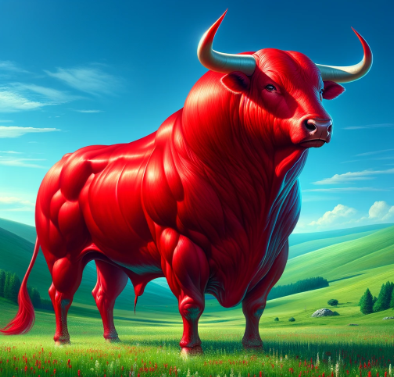Old Ox Brewery is a small family owned and operated brewery, winery and distillery. They have brands like Robot Dreams and Hoppy Place. In 2014, they filed two trademark applications for OLD OX BREWERYtrademark and its logo, below:
Out of the blue, Red Bull opposed the registrations of these two marks, claiming that they were confusingly similar to their RED BULL trademark. They claimed that trademarks RED BULL and OLD OX BREWERY are confusingly similar.
The reason? According to the opposition, “An “ox” and a “bull” both fall within the same class of “bovine” animals and are virtually indistinguishable to most consumers. In addition, an ox is a castrated bull“.
Red Bull’s contention was that because of this conceptual link between an ox and a bull, and average consumer would not be able to distinguish the OLD OX BREWERY trademark from the RED BULL trademark.
Why do big companies behave this way?
Big companies know that brands are their most valuable assets. Consequently, they protect them jealously. They also know that small companies might not have the resources to fight back and defend themselves even against unjustified claims.
Normally, a trademark opposition requires that there is a “likelihood of confusion” between the marks.
However, when the earlier has “reputation” (is “well-known”), it not required that the owner can establish a likelihood of confusion between the marks. Well-known marks get broader protection, and this sometimes leads to large companies overreaching.
Their worry is often not so much that consumers will confuse the brands, but to prevent small companies from taking an unfair advantage of the fame of the famous mark. This can happen if the smaller company’s mark resembles the famous mark to the extent that it brings it to mind even if there is no confusion between the marks.
Large companies say that they are protecting their investments made to the brand, and that they are merely using those means that are given to them by law.
As often with other trademark disputes, it is not easy to say which marks are similar and which are dissimilar. This is even more the case with famous trademarks, where similarity is not a requirement, only that the later mark creates some kind of association with the famous mark.
Still, most would probably agree that the OLD OX BREWERY trademark does not bring trademark RED BULL in mind.
What do trademark bullies do?
It is common for them to send cease-and-desist letters with threatening language. These letters often demand that the recipient immediately cease using the alleged infringing trademark, even if they have been using it for years without issues. The letter may also include demands for compensation and a threat of litigation if demands are not met.
The bullies can initiate lawsuits or oppositions without valid grounds. These lawsuits can be costly and time-consuming for the defendants. Even if the cases are meritless, the small company is entangled in an expensive dispute.
Trademark bullies use their resources to overwhelm smaller businesses. Trademark bullies have access to significant resources, allowing them to drown smaller businesses in legal fees, administrative costs and uncertainty about the future of the trademark. With this uncertainty, it is difficult for small companies to invest more in the brand. This can force the smaller businesses to either abandon their trademarks or enter into unfavourable settlements.
How can you protect yourself against bullying?
It can be difficult to protect yourself against bullying. Surely the owners of the Old Ox Brewery did not anticipate that Red Bull would take issue with their trademark. Even a diligent trademark search and legal opinion from a lawyer would likely not have concluded that there is a major risk regarding Red Bull’s trademarks.
That’s the challenge. Trademark bullies’ actions are unreasonable, so even diligent conduct, such as proper trademark searches, do not shield you from them. The good news is that bullying is not that common.
Also, trademark oppositions in Europe are thankfully much less expensive than in the US. A trademark opposition in the US can cost more than a hundred thousand dollars, whereas in the EU it is only a fraction of that. In many European countries, the cost of a trademark opposition is around a few thousand euro.
If you are faced with a trademark bully, the first thing to do is to get advice from an experienced trademark attorney. You should do this before responding to the bully or giving into the bully’s demands.
Sometimes the best defence against bullying is publicity and the negative PR that comes with it. For example, Hugo Boss got a lot of bad publicity when they sent a cease-and-desist letter to a small brewery Boss Brewing in Swansea, Wales, for using the word “BOSS” in their beers.
Once the story became public, the British comedian Joe Lycett changed his name to Hugo Boss in support of the brewery and made tweets about Hugo Boss’s Nazi past. The saga got a lot of media coverage in many countries.
If you plan to use the media and PR route, it should be done with a lot of caution. Making unfair or untruthful statements about other companies could put you in risk of liability for unfair business practices. So even if you are frustrated with the situation, your response must be carefully thought out.
Conclusion
In the end, while the battle between small businesses and trademark bullies is not easy, it’s essential to remember that the legal system and public opinion can provide avenues for obtaining a favourable result. With determination and right guidance, even the smallest companies can stand up to the trademark bullies and protect their own brand identity. The first thing to do, though, is to get legal advice from a trademark attorney.
Read more
Reputation – trademark’s superpower
Somebody is infringing your trademark – what should you do?




